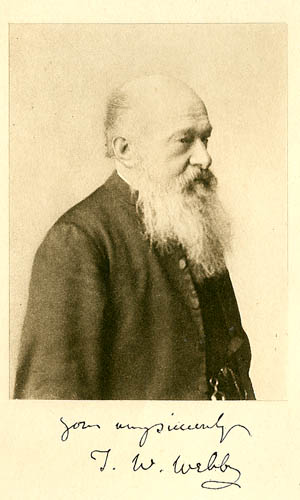
In 1859 the Rev. Thomas William Webb published the first edition of Celestial Objects for Common Telescopes. This two volume work was written as a guide the the amateur astronomer, containing instructions on the use of a telescope as well as detailed descriptions of what could be observed with it. This work quickly became the standard observing guide of amateur astronomers, and remained so for many decades.
Common telescopes in the title refers to refractors of 3 to 6 inches and the somewhat larger reflectors that were commonly available to the amateur observers of the day. While achromatic refractors were quite popular in the last half of the 19th century, silver on glass reflectors were becoming increasingly available and gave the observer greater light gathering power for a cost that could be afforded by many. Thus there was a need for a simple, clearly written guide to these telescopes, how to use them and what to observe with them.
Rev. Webb was an anglican minister assigned to a small rural parish at Hardwick in Herefordshire, England. Here he served for the remainder of his career, dutifully ministering and caring for his parishioners. His one avocation, aside from the work of the parish, was astronomy. On the grounds of the vicarage was erected a small canvas and wood observatory that was home to a number of instruments across the years. From a small 3.7" refractor Rev. Webb acquired a number of progressively larger refractors and reflectors with which the observations in the guide were made. The largest telescope was a 9-1/3" silver on glass reflector used from 1866 to his last observation in March of 1885.
While first published in 1859, Celestial Objects for Common Telescopes was continually published through the sixth edition in 1917 edited by Rev. T.E. Espin. In 1962 a final edition was published by Dover Press, edited by Margaret W. Mayall. It is this last edition that is commonly found by amateur astronomers on used store bookshelves as it remains easy to obtain and can be had quite cheaply. Earlier editions have become collectors items and are quite rare.
These books remain a fascinating glimpse into the scientific understanding of the universe in the late 19th century. Much was known of the sky but so little was yet understood. The true nature and distances to the stars and nebulae remained a great mystery. The planets remained true mysteries where wild speculations about the features observed through the telescopes of the day were common. Many of these speculations would not be truly challenged and settled until the space age a century later when probes first visited these enigmatic neighbors
The first volume is a manual in the use of the telescope and a guide to the Sun, Moon and planets. The second volume a guide to the stars, clusters and nebulae arranged by constellation. In this second volume far more attention is paid to the stars, double and variable, than to the nebulae, not surprising given the smaller apertures in use as well as reflecting the priorities of astronomy at the time. A typical constellation may list over 100 interesting stars, and only a handful of cluster and nebulae. The deep sky object descriptions range from a terse single word 'Nebula' to poetic descriptions a page or more long quoting from scripture or other observers like William and John Herschel or Piazzi Smyth.
It is these descriptions that make the books enjoyable to use even today, over a century and a half later.